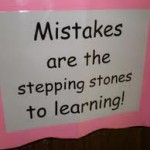From Laura Ingalls in her one room school house on Little House on the Prairie to Horshack’s “ Oooh, ooh ooh” in Mr. Kotter’s  70’s classroom to Rachel Berry in Glee, we have images of students raising their hands to share their knowledge. We see it every day in classes all over the world.
70’s classroom to Rachel Berry in Glee, we have images of students raising their hands to share their knowledge. We see it every day in classes all over the world.
As a classroom teacher, I’ll admit that when it came time to choose which student to share the answer, it was usually a student whom I assumed had the correct answer. Back then, my thinking was that the other students needed to know that their answer was also correct or that they had not quite figured out the right answer. I’m also assuming that I, as the teacher, wanted the affirmation that what I had taught had been internalized and “learned” by the student who was sharing the correct answer.
After reading Carol Dweck’s Mindset ~ The New Psychology of Success, I’m positive that if I were to return to a classroom, my philosophy of “the right answer” would be dramatically different and I publically apologize to my former students. If I had known better, I would have done better (Maya Angelou)
Dweck asks a poignant question ~ “Isn’t that what school is for, to teach? They’re there to learn how to do these things, not because they already know everything”. By asking the student with the right answer, I wasn’t really teaching those who needed me, was I? Back then, mistakes were something to be avoided. The smart students got smarter, raised their hands more and received better marks on their report cards. For those students who were struggling, we worked in small groups, where I provided them with “modified” work which they could complete, instead of having them share their answers with the whole group and taking that opportunity for all of us to learn together.
As today’s educators, we need to instill a growth-mindset in our students, so that they view mistakes as an opportunity for feedback and learning.
If we do that then, we’ll be supporting students “whose primary goal is to expand their knowledge and their ways of thinking and investigating the world. They will not see grades as an end in themselves but as a means to continue to grow”.
We need to create learning environments where learning is truly the work that is happening. Not environments where teachers provide easy tasks, record who gets it and who doesn’t and then move on. Classrooms need to be places where standards are high, mistakes are a part of the culture and both educators and students are learning.
How do you handle “mistakes” in your classroom? Is learning truly at the heart of what you value in your classroom? If so, how do you make that visible for your students, your colleagues and the rest of your school community?
Come write with me….


